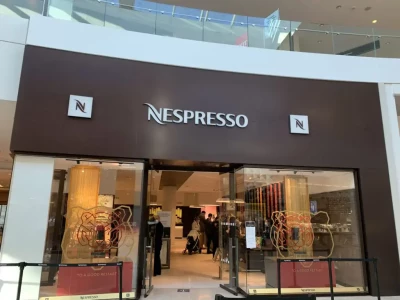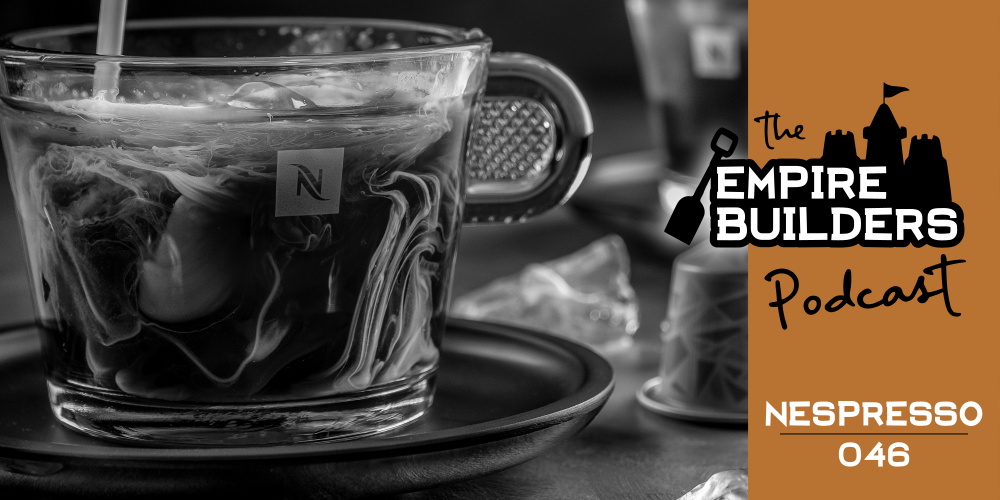Nespresso, a startup that failed twice before it took off, even though the machines were cheaper, no training was required, and it produced better quality coffee. It took glamour to create a successful launch.
Subscribe: Apple Podcasts | Google Podcasts | Amazon Music | Blubrry | RSS | More
Dave Young:
Dave young and Stephen Semple here on The Empire Builders podcast. And Stephen, I understand that we’re going to talk coffee today, and not just coffee, my favorite little coffee machine is the Nespresso.
Stephen Semple:
It is a lovely coffee. It’s a unit of Nestle, so it is part of a big company, but there’s still a bunch of things we can learn from it. But just to give you an idea of how big Nespresso has got, is today they sell about 14 billion of those little capsules a year. And there are 400 Nespressos drunk every second. So, 400-
Dave Young:
Wait.
Stephen Semple:
Just happened.
Dave Young:
400 every second. Gulp. Gulp.
Stephen Semple:
And Nespresso also has stores. They also have these retail stores and they have about 700 of those worldwide. And in 2011, they had annual sales in excess of about 3 billion Swiss franc, and the Swiss franc’s pretty close to the US dollar. So they’ve really become a force in the coffee business.
And the idea of the Nespresso was invented by Eric Favre, and he was an employee of Nestle. And when he noticed he was in the coffee bar near the Pantheon in Rome, Italy. And he noticed there was this one coffee bar that had way more customers than everybody else.
Being an engineer, this caught his eye. They were using pretty much the same coffee machines. They were using the same coffee, but one had better coffee. Back in those days, the espresso machines in the coffee shops are the ones, you know, with the big lever that you pulled? It wasn’t just pressing of a button.
Dave Young:
Whoosh, whoosh. Steam, steam. You look like you’re operating some kind of a locomotive or something, right?
Stephen Semple:
Yeah, exactly. And that’s where the expression pulling an espresso comes from, right? Like making an espresso’s called pulling an espresso. And that’s where it comes from. But back to Eric.
He noticed that the guys were pumping the piston several times before releasing the coffee, while the competitors did it just once. And this forced more water and more air into the coffee grounds, creating greater oxidization and more flavor, and hence more crema. Remember crema?
Dave Young:
More crema? Yeah, the beautiful little foam that sits on top of a cup of the coffee.
Stephen Semple:
Yeah. And the story gets even funnier when you consider the origin of the idea of La Crema, which was something that was created by Gaggia. And you really need to go back to episode 16 and listen to that story a few months back, because it’s really quite hilarious.
Dave Young:
Yeah. Because it’s kind of crazy.
Stephen Semple:
It is kind of crazy. Eric invented the Nespresso machine, which was designed to inject pressurized hot water. And it’s actually not a simple machine. It looks simple, but there are over 1,700 patents on that machine. And when you look at the pods, they’re very different, they’re metal. And the top clamps down. And all of that is to create that high pressure.
And when they first marketed this idea, they thought, “Let’s go to the restaurant trade,” because what they saw was this would be a way for small restaurants to offer better coffee with less capital, because the machines are way cheaper than those $10,000 fancy espresso machines, no training needed. Pop the thing in, close it down, press the button.
Dave Young:
Just push the button.
Stephen Semple:
Yeah. And was first introduced in the Swiss market, Nestle’s home in 1982, a market they know, a market that they were selling lots of things to restaurants, did not catch on. And you would think that would be a slam dunk. Cheaper, no training, better quality product. You’d think that would be a slam dunk, right?
Dave Young:
Even if you had the little machine in the back, you wouldn’t have the show. And so how would people believe that they got a good espresso pull? But so it didn’t catch on with restaurants?
Stephen Semple:
So then they decided on the office market, right? So they thought, “Well, that would be… So they redesigned the machine, they made it smaller and they relaunched it in 1986 in Japan and Italy. Nope, didn’t work in the office market.
So they hired an outside guy to take a look at this. They brought over a guy, Jean-Paul Gaillard from Philip Morris. And he said, “Consumer market. Let’s target the consumer market.” But what he did is he created this two-tier selling approach. Sell the machines through department stores and specialty retailers, and then sell the pods directly to the consumers, create a coffee club. And position it as premium, exclusive and distinctive. And really remember La Crema.
 And this worked and they did an amazing job advertising this. There was ads created by Interpublic’s Martin Agency. The earlier ones used Penélope Cruz, and La Crema was unique to the product. They also did a number of ads using George Clooney, especially the first ones that had Danny DeVito in them. There was this line of, “I want in.” La Crema was unique to the product, but they wanted to highlight it, not educate.
And this worked and they did an amazing job advertising this. There was ads created by Interpublic’s Martin Agency. The earlier ones used Penélope Cruz, and La Crema was unique to the product. They also did a number of ads using George Clooney, especially the first ones that had Danny DeVito in them. There was this line of, “I want in.” La Crema was unique to the product, but they wanted to highlight it, not educate.
And I feel like all of this has gone really this full circle back to Gaggia, which also discovered that. But they show the coffee in this beautiful glass mug, and you can see the cream on the top. And the guy asks, “How did they make this froth?” And then there’s this close up of Cruz looking right in the camera with her sexy accent and voice and says, it’s La Crema.” So creating this exclusive feel without telling people about it.
And then in 2000, they opened their first boutique. And here we are 20 years later and they’ve got 700 of them. And when you walk into them, they don’t feel like a retail store, they feel like a high end coffee shop.
Startups can be really hard. You think about Nestle, big company, lots of research and development. Lots of people started this up selling to restaurants in a market that they knew and all those other things. And it took them three kicks at the can, three iterations of this product to get it to where it is today, right?
Dave Young:
Mm-hmm (affirmative). To have the will and the realization to say, “Well, no, we need to pivot again.”
Stephen Semple:
Right.
Dave Young:
Right. We know this is a great product, but we have not found the market yet. And so to be able to test and come to those kinds of realizations before you give up, is important.
Stephen Semple:
Absolutely. But the other thing is that, don’t educate people. They never did the whole, “Our coffee’s better and it’s better for these reasons. And it’s better for these reasons. And it’s better for these reasons.” They did not do that. They didn’t educate people. They made, in their ads, and in the show notes we’ll have a couple of examples of the ads, they made you feel that the coffee was special and better.
Dave Young:
They treated it with some aspects of glamour.
Stephen Semple:
They did, absolutely.
Dave Young:
Right? They made it feel more luxurious than any other coffee you could have. Even if you went to a coffee shop, right, you’re probably not going to get this.
Stephen Semple:
Yes. And then the other thing that they did that I thought was really interesting, is a lot of times when businesses want to sort of go, “I want to create an exclusive feel,” or “I want it to be exclusive.” They say the words exclusive. “This is an exclusive offer.”
Dave Young:
Mm-hmm (affirmative).
Stephen Semple:
As soon as you say it, it’s no longer true, right? Like, “I’m a funny guy.” You probably aren’t. “You can trust me.” You’re probably not trustworthy. Right? They managed to make it feel exclusive without saying the word exclusive. That’s why I love the Danny DeVito line, “I want in.”
Dave Young:
“I want in.” Yeah. That’s perfect ad writing.
Stephen Semple:
Yeah.
Dave Young:
I want in because Danny DeVito represents you and me, and George Clooney represents this glamorous figure that we know we’re never going to be. Yeah, I want in, even if I’m just hanging with George, right?
Stephen Semple:
Right. Yeah.
Dave Young:
Having the same cup of coffee.
Stephen Semple:
Yeah. It was this great way of creating that feel of special and exclusive and all this other stuff without saying it. And that’s where the magic is in those ads.
Dave Young:
We could talk about business model to build the machine and then create this club so that you have to keep buying the pods. We’ve seen that in so many businesses, but that’s super smart too. You can’t just dump any old coffee in this thing either.
Stephen Semple:
Right. Right.
Dave Young:
They really locked up the market. They created the exclusivity, the glamour, and then made it a club that you don’t ever want to quit.
Stephen Semple:
Exactly. Exactly. So while it’s a big company, it really is a neat story where there’s lots of things we can learn from it.
Dave Young:
Yeah. Amazing. I’ve got to go have a cup now. Thanks, Stephen.
Stephen Semple:
All right. Yeah. Enjoy.
Dave Young:
Thanks for listening to the podcast. Please share us, subscribe on your favorite podcast app and leave us a big fat juicy five star rating and review. And if you have any questions about this or any other podcast episode, email to questions@theempirebuilderspodcast.com.
- How Hot Wheels Beat Matchbox. When Imitation Becomes Innovation. - April 22, 2024
- She took a gamble and bet on girls. How Barbie defied expectations and won. - April 15, 2024
- The Birth of the Rubik’s Cube: A Tale of Unexpected Opportunity - April 8, 2024

